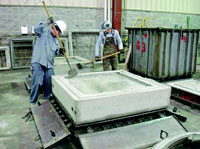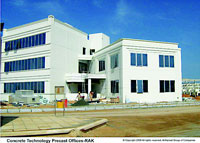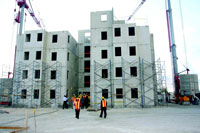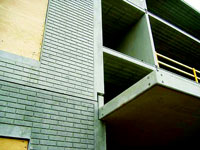Future of Precast construction in mass housing in India
Dr B Sivarama Sarma, Head, Research & Development, L&T Construction
Conventional construction practices and its syndrome
| Concrete is the most versatile construction material. Innovations in cement manufacturing process have made the concrete as the best sustainable construction material. India produces varieties of cements and most popular ones are OPC 33, 43, 53, PPC and PSC. Crusher over run or usually called as crusher dust has come into today’s concrete mix design practice due to non-availability of river sand. The concrete mix suitably be adjusted on daily basis with moisture correction of raw materials and also to account the seasonal and strength requirement at the site in a batching plant establishment. Concrete mix design varies with the type of element and the construction process. As an example, a prestressed slab of grade M30 when compared to usual conventional slab of M30 grade may require high early strength to complete the prestressing operation and improve speed in floor construction. About 80-90% of residential house constructions are carried out through simple mixer machines by the labour gangs and masons. The quality of such concrete works usually |


|
is empirical with unskilled construction practices and lead to wastage of materials and labour about 5-10%.It may appear notionally that the cost is low but time delay in completion of the project is significant. Hence, in mass housing projects in addition to cost, selection of materials and method of construction practices govern the quality of construction.
Conventional construction practice with concrete which is very popular in India goes by form work erection and pooling up of labour and skilled masons on intermittent basis at sites. Every building site also has the environmental challenges like winter, summer or rainy seasons. So the productivity changes from site to site. So, mechanised construction eliminates the environmental influence and major labour force tasks at the site.
The construction method by heavy metal forms are now slowly replaced by lighter aluminium or composite forms which are friendly to labour. The bamboo staging systems have become obsolete. Though the light metal forms are expensive they are selected due to more repetitions. A self-contained development site by regular conventional methods may take at least 5 years period. Very often such projects with low bid selection criteria may suffer due to cost escalation and delay in completion of project and often influence the quality of construction.
Many of the common residential flats are of the modules of 30, 45, 75, 100, 120 and 160 m2. As an example, in EWS housing unit of 30 m2 module, minimum carpet area of 12.5 sq.m is to be provided in living hall. The amenities like toilet, kitchen, and balcony are appended to the living module by another 8 sq.m of space. A block of 25sq.m module with four floors which has about 16 houses (5 persons per family) may cause the density of living population 5sq.m/per person.NBC considers the community area up to 1000 units. By considering the guidelines of NBC, the standard modular units and elements for housing can be developed. Each state or a region or a development project can be arrived at the standard panel sizes, beams, columns, floor planks, architectural facades etc. Once the standard units are popularized and made available as factory made good quality items at economical price, then the regular construction site practices will cease. The speed of construction can be reduced by 50% when total mechanisation process in housing is promoted.
In India it can be noticed that the student’s morale to take up civil engineering as the professional carrier is found to be below compared to the other fields of engineering disciplines like computers and communication, electrical, electronics etc. The civil engineering curriculum notionally understood by many common people as a profession of brick and mortar construction in hot sun environment. Construction industry is still treated as a high unskilled labour intensive operation with not much of professional curriculum as the basic need of entry. The curriculum has little advanced courses to enthuse the students on mechanized construction practices. Lack of integrated curriculum practices such as developing the concepts of form work design, advanced materials applications, high rise structures or high value infrastructure projects construction or total precast mass housing construction including the MEP services could be a major reason for the students not favourable to choose civil engineering as a profession. The gap between the practice and schools curriculum is widening. Lack of many vocational skill training programmes for the labour and specialised certificate programmes in various disciplines of civil engineering like contracts management, BIM models, architectural planning, land management, building acoustics, thermal comforts in buildings, advanced foundation construction methods, mechanised construction of buildings for regular practicing engineers is also the cause for under developed practices in building construction. Simple, fast and standard mechanised construction technology practices in housing sector will promote rapid mass housing development in a short span in India.
Review of precast construction practices in India
| Precast construction also known as mechanised construction started in India in early 1970s. Mass housing by precast construction was extensively practiced by Russia, Poland, Hungary, Germany etc., and was supported by the respective Governments. In Singapore, Hong Kong, China mass housing was promoted due to the benefits in speed of construction, limited skill requirement and high quality demand. In earlier days Indian government also supported many institutions and a few industries to design and develop precast products for housing. The popular precast building components developed were channel slabs, waffle slabs, light weight blocks, door frames, and architectural facades etc. Precast housing systems were not popularised due to high capital investment in manufacturing plant and lack logistics for lifting and transportation of elements and no unified approach on standardization of elements. The value engineering provided by mechanised speedy construction was never visualised as a major influencing parameter in awarding the contracts up to |


|
late 2010. Hence, not a few significant total precast building projects from architectural planning to total construction can be sighted in India. Currently some of the industries are producing the hollow core slabs, precast spun piles, wall units etc. L&T construction initiated its first major project of residential towers in Mumbai and many such projects are coming up in future.
Drivers to promote precast industry growth
There are many merits (see table 1) due to mechanised precast construction over conventional construction in housing sector. Mechanised construction is one of the important parameters of development. Any nation’s progress can be judged by looking at the practices of advanced mechanised construction skills. Construction practices in housing need improvement in quality, cost, and reducing period of construction and wastage of materials. Three aspects primarily to be focused to promote the precast industry in India;
- Precast technology should be made friendly to students, architects, professionals and researchers.
- Government to handhold the precast industry till its incubation particularly to promote rapid development of mass housing projects.
- Developing training institutes on precast technology.
In the first task there is great need of a Handbook to explain the precast construction technology. Indian Concrete Institute, ICI had initiated the major project with the support of IIT Madras, SERC, L&T and many other industry partners.
There are a few major difficulties hindering the growth of precast industries. A) Absence of modular systems which increase capital investment. B) Lack coordinated approach between government and industry in promoting mass housing projects.
Vocational training schools and certificate programmes at academic and industry level will promote the latest developments in precast technology standards and construction practices.
Conclusions
Precast concrete technology is already a proven one in rapid development of mass housing programmes. The shortages and productivity limitations can be eliminated by mechanised process. The natural materials are shortly getting exhausted and greater care should be exercised so that obsolete conventional practices can be eliminated.
Acknowledgements
Indian concrete Institute, Chennai centre efforts and all the institutes and industries supporting this cause to bring out the handbook are gratefully acknowledged.
|
S.No.
|
PRECAST SYSTEM
|
CONVENTION METHOD
|
|
1
|
Material quantity 0.8-0.9 X m2
|
Material quantity X m2
|
|
2
|
Completion time of each floor 0.25X weeks
|
Completion time of each floor X weeks
|
|
3
|
Time duration 50%X months
|
Time duration X months
|
|
4
|
Amount of temporary supports 20% V
|
Shuttering materials volume V
|
|
5
|
Wastage in rebars 2%
|
Wastage in rebars 5%
|
|
6
|
Wastage in other materials like Concrete, water etc., 1-2%
|
Wastage in other materials like Concrete, water etc., 5-10%
|
|
7
|
Environmental friendly like less construction noise, pollution, and sites are clean
|
Not environmental friendly due to noisy and shabby organisation of incoming and outgoing materials and movement of logistics in constrained space.
|
|
8
|
Less accidents prone as the number of labors used 10-20% X. Industrial manufacturing climate in closed environment like in automobile industry units.
|
More accident prone throughout the construction period and the number of labors involved are more (X) and high risk level management of conflicts, facilities, movement etc.,
|
|
9
|
Internationally practiced and proven systems and have more clarity on contracts, quality and delivery of project schedules. Value addition like improving thermal & acoustic comforts of buildings, good architectural detailing etc., are easily possible at less cost.
|
It is difficult to add value engineering at low cost as the volume consumption is less. The standard contracts need to be improved.
|
Table 1 Benefits of precast construction in housing projects